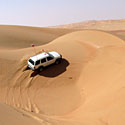Re: Must Read for Newbies
- This topic has 11 replies, 11 voices, and was last updated 3 years, 5 months ago by
ronakchoudhary.
-
AuthorPosts
-
 December 12, 2010 at 3:54 am #863
December 12, 2010 at 3:54 am #863Sand Driving Safety Basics
The fundamental theme with sand driving is to conserve your momentum. Since traction is at a premium, any increase in speed can be difficult, if not impossible, and you do not want to lose any
momentum, as you may not be able to regain it.Tyre Pressure
The first thing to do before driving on sand is to lower your tyre pressures. This is done to provide better flotation by increasing the size of your “footprint” and thus dramatically improving your traction. It also
reduces the amount of strain on your vehicle and minimizes wear and tear on the tracks. The optimum tyre pressure depends on your vehicle, the type of tyres fitted and the terrain. The
following technique provides a good starting point to find the optimum pressure and is best performed before leaving the bitumen.Park your loaded vehicle on a level surface and place a brick 1 cm away from the sidewall of your rear tyre. Deflate that tyre until the sidewall just touches the brick and then measure the tyre pressure. Use
this pressure as your starting point when initially lowering your tyre pressure for sand driving. As you become more familiar with sand driving, you can alter this pressure as the terrain dictates.
If you haven’t performed the above technique before you reach the sand, don’t fret. A good rule of thumb is to use a pressure of 15 psi.Remember though, if you are going to lower your tyre pressures, ensure you have a pressure gauge and some means of pumping your tyres back up.
As you lower tyre pressure, the tyre becomes more vulnerable to damage by stoking the sidewall or rolling the tyre off the rim. The lower the pressure, the higher the risk. However the gain in traction can
be remarkable and may make the difference between becoming hopelessly bogged or simply driving away. The “correct” tyre pressure becomes a decision between better traction versus increased risk of
tyre damage.
In severe cases of bogging, tire pressure can be lowered to a minimum of 40 kPa (6psi), as most tyres require at least 6psi to remain seated on the rim while stationary. In almost all situations 10psi should
be used as the minimum pressure as 6psi is likely to result in tyre damage ie. tyres rolled off rims or punctured sidewalls. Speeds should be severely restricted at these low pressures. To minimize tyre
damage, it is important that these low pressures are only used on sand and tyre pressures should be increased if limestone or rocky outcrops are encountered, or when the terrain becomes more firm.
Failure to do so will almost certainly result in tyre or rim damage.Sand Driving Techniques
When traveling on sand, you should endeavor to follow in the tyre tracks of the vehicle in front as they have already compressed the sand to form a firmer surface than un-traversed ground. Never drive on
vegetation as this will destroy it and lead to erosion and environmental damage.
You should avoid rapid changes in speed when accelerating or braking. Braking on sand will cause a mound to build up in front of all wheels and possibly prevent your vehicle from taking off. Rapid
acceleration simply digs the wheels in and can actually lead to slower take-off speeds.
Take-off should be performed as smoothly as possible with gear changes done at fairly high revs. Sand driving requires plenty of engine power to get your vehicle “planing” on the sand. It is advisable to use
low range as this multiplies the amount of engine torque available and will provide that extra gear if you encounter a particularly soft patch of sand. Check that your tyres are pointing straight ahead when
taking off to reduce the takeoff effort required.
When stopping on sand, depress the clutch and allow the vehicle to coast to a stop. This will minimize any sand build-up in front of the wheels. If the terrain permits, coast to a stop, rather than braking, with
the vehicle pointing downhill as this will aid take-off. Avoid the soft sand at the base of most dunes and gullies when stopping.
When turning, make the turn as wide as possible to reduce the chance of bogging. Your front wheels act more like a rudder in sand and turning too sharp has a similar effect to applying the brakes.
Steep sand dunes can be traversed only straight up or down. If you drive even on a slight angle, the weight transfer is to the downhill side wheels. If the vehicle starts to slip, the downhill wheels tend to
dig in and make the angle of the dune even worse, leading to a potential rollover.
If you are traveling straight down a steep dune and the back end starts to slip sideways, it is best to accelerate slightly to try and straighten the vehicle. Never use the brake, as this will cause weight
transfer to the front wheels and can increase the back end movement.
If traveling up a dune and you do not get to the top, reverse down the dune in gear, NEVER coast down the dune and NEVER attempt a U turn, on the gradient.
When you return home after a beach trip, it is important to hose down your vehicle to remove all traces of sand and salt. Pay special attention to areas like the mudguards where sand is sprayed around and
tends to get trapped. Thoroughly hose underneath your vehicle as well, as there are many nooks and crannies where sand con also get trapped.Vehicle Recovery in Sand
As soon as you become bogged, avoid the temptation to simply floor the accelerator as this will just make vehicle recovery more difficult. Put the vehicle in reverse and gently try to back along your tracks
as they provide a compacted path. When you have reversed a sufficient distance, try going forward again while being careful not dig yourself in. Hopefully you will travel further each time you repeat this
technique and eventually be able to slowly pass through a particularly soft section.
If you cannot reverse out of trouble, get out of the vehicle and let your tyres down further. A rule of thumb is to drop them by a further 12 psi. Before trying to reverse out, remove the build-up of sand
from behind the tyres. See if any part of the underside is touching. If it is, clear the sand away to allow the vehicle to reverse out. You may need to try this several times.
If necessary, continue to drop the tyre pressures to 10 psi. Also, never underestimate the assistance of your passengers giving a push. As mentioned earlier, tyres can be lowered to 6psi in extreme cases, but
this should be avoided if other means of vehicle recovery are available.
If you are still stuck and your tyres are down to the minimum pressure, you will have to resort to a snatch strap, winching or jacking to extricate yourself. The easiest method is usually by snatch strap, but
this relies on another vehicle being present. If you are by yourself, you will have to resort to winching (if you have one!) or jacking.Summary-Sand Driving
• lower tyre pressures to greatly improve traction and reduce track erosion
• drive smoothly with gear changes at high revs
• ensure wheels are pointing straight ahead when taking off
• avoid the soft sand at the base of dunes and gullies
• make turns as wide as possible
• ONLY travel straight up or down dunes
• follow in others tire tracks to drive on compressed ground
• avoid braking by coasting to a stop
• do not floor the accelerator if you are bogging down
• when bogged, try to reverse on your own tracks
• thoroughly hose down your vehicle after a beach tripJanuary 8, 2012 at 11:52 am #15278Another tip (from an desert driving instructor, and tested by me successfully…):
First always make sure you are in P and EB on (to prevent accidental movement)
Second, assess the situation and attempt to get unstuck:
Case 1) Assuming the chassi is off the ground (you can shake the car sideways):
– switch to 4L (and diff lock if available)
– turn off A/C
– unload car (passengers primarily)
– decide the right way to attempt to move (taking geography, gravity, and the car’s position into account)
– carefully attempt to get unstuck, rev up to 1500, max 2000, turning the steering wheel full left & full right (back and forth), until you to start to move
– if/when you start to move, continue (use the momentum), and stop moving the steering wheel (since you now have some grip)Case 2) Assuming the chassi is firmly in the sand (i.e. you can NOT shake the car)
– get the shovel out and clear the chassi (wheels not so important)
– then turn to method 1) above


-
AuthorPosts
- You must be logged in to reply to this topic.

